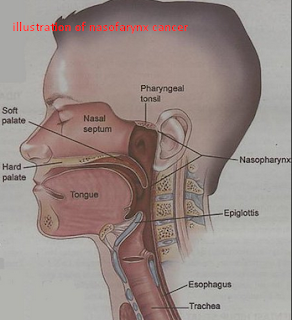 |
| Illustration of Types of Brain Cancer - Brain Cancer Treatment, Causes, Symptoms |
Unlike other types of cancer, cancer of the brain or spinal cord cancers rarely spread to distant organs. They cause damage because they spread locally and destroy normal brain tissue at the place where they appear. However, cancer of the brain or spinal cord rarely considered "benign". Unless they have actually been removed or destroyed, the majority of cancers of the brain or spinal cord tumors will continue to grow and eventually lead to death.
Primary brain cancer can start in one type of tissue or cells in the brain or spinal cord. Some tumors contain a mixture of cell types. Tumors in different areas of the central nervous system can be treated differently and have different prognoses.
A. gliomas :
Glioma is a general term for a group of brain tumors that begin in glial cells. Some tumors can be thought of glioma, including glioblastoma, astrocytomas, oligodendrogliomas, and ependymomas. About 4 out of 10 cases of brain cancer is glioma. When counting cases of malignant brain cancer, about 8 out of 10 are gliomas.
A1 . astrocytomas :
Most tumors that arise in the brain itself begins in glial cells called astrocytes. These tumors are called astrocytomas. Statistics incidence is approximately 3 out of 10 of brain cancer.
Most astrocytomas can spread throughout the brain and fused with normal brain tissue, which can make them very difficult to be surgically removed. Sometimes they spread along the main nervous system pathways. It is rare for them to spread outside the brain or spinal cord.
Grade astrocytomas often classified as low, medium, or high grade, based on how the cells look under a microscope.
- Low-grade astrocytomas : the type of the slowest growing
- Anaplastic astrocytomas : grow at a moderate rate
- The highest grade astrocytoma ( or glioblastoma multiforme ) : the fastest growing. These tumors make up about two - thirds of astrocytomas and is the most common type of brain cancer ( malignant ) that affect adults.
A2. Oligodendrogliomas : This brain tumors start in brain cells called oligodendrocytes. Such as astrocytomas, most can infiltrate into nearby brain tissue and can not be completely removed by surgery. Oligodendrogliomas sometimes scattered throughout the central nervous system pathways but rarely spread outside the brain or spinal cord. Very aggressive type of tumor known as anaplastic oligodendrogliomas. Only about 3 % of brain tumor type oligodendrogliomas.
A3. Ependymomas : Brain tumor is derived from ependymal cells, which line the ventricles. Ependymomas may block the outflow of the central nervous system of the ventricles, which causes a condition called hydrocephalus.
Astrocytomas and oligodendrogliomas Unlike, ependymomas usually do not grow to infiltrate normal brain tissue. As a result, some ( but not all ) ependymomas can be completely removed and cured by surgery. Spinal ependymomas have the greatest chance to be cured through surgery. Ependymomas can spread along the CSF pathways but did not spread outside the brain or spinal cord. Its most aggressive form known as anaplastic ependymomas and usually can not be cured by surgery. Only about 2 % of brain tumor type ependymomas.
B. meningioma
Meningiomas are the most common brain tumor in adults. They arise from the meninges, the layers of tissue that surround the outside of the brain and spinal cord. Meningioma contribute to about 1 in 3 primary brain cancer and cancer of the spinal cord.
This type of brain tumor risk increases with age. They are about two times more common in women. In some cases the tumor is genetic (inherited ), especially in those with neurofibromatosis ( syndrome of benign tumors on nerve tissue ).
Meningiomas cause symptoms by pressing the brain or spinal cord. About 4 out of 5 meningiomas are benign, and most can be cured with surgery. But some meningiomas grow very close to vital structures in the brain and can not be cured with surgery alone. A small number of malignant meningioma and may come back many times after surgery or even spread to other parts of the body.
C. medulloblastomas
Medulloblastomas are brain tumors that develop from neuroectodermal cells ( primitive nerve cells ) in the cerebellum. They are a fast-growing cancer and often spread throughout the cerebrospinal fluid pathways, but they can be treated with radiation therapy and chemotherapy. Medulloblastomas occur more frequently in children than in adults. They are part of a class of tumors called primitive neuroectodermal tumors ( PNETs ) that may occur in the brain and elsewhere in the central nervous system.
D. Gangliogliomas
Brain tumors containing neurons and glial cells called a ganglioglioma. It is very rare in adults and has a high prospect of cure with surgery alone or surgery combined with radiotherapy.
E. Schwannomas ( neurilemomas )
Schwannomas originate from Schwann cells, which are part of the myelin forming cranial nerves and other peripheral nerves. This type of brain tumor is usually benign. They can arise from cranial nerves. When they form a tumor of the cranial nerve that is responsible for balance near the cerebellum, vestibular schwannomas or they called acoustic neuromas. They also may arise from the spinal cord after they have left the spinal cord. Schwannomas make up about 9 % of all CNS tumors.
Other tumors that can be started in or near the brain :
Chordomas : These tumors are rare start in the bone at the base of the skull or at the lower end of the spine. Chordomas not of the central nervous system, but they can cause injury to the nervous system by tapping nearby. These tumors are treated by surgical removal if possible, followed by radiotherapy, but they tend to come back in the same area after treatment, which can cause progressive injury and death. They usually do not spread to other organs.
Non - Hodgkin lymphoma : Lymphoma begins in the lymphocytes (a type of primary cells of the immune system ). Some types of lymphoma central nervous system ( CNS ) occurs in people with immune system problems, such as those infected with HIV. The development of new treatments for AIDS, causing brain lymphoma types become less common in recent years. Often highly malignant lymphoma of the brain and can be difficult to treat. The latest advances in chemotherapy, however, has improved the prognosis of patients with this cancer.











